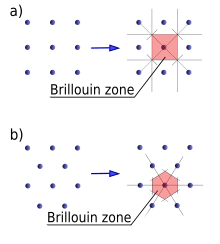Brillouin zone

In mathematics and solid state physics, the first Brillouin zone is a uniquely defined primitive cell in reciprocal space. The boundaries of this cell are given by planes related to points on the reciprocal lattice. It is found by the same method as for the Wigner–Seitz cell in the Bravais lattice. The importance of the Brillouin zone stems from the Bloch wave description of waves in a periodic medium, in which it is found that the solutions can be completely characterized by their behavior in a single Brillouin zone.
The first Brillouin zone is the locus of points in reciprocal space that are closer to the origin of the reciprocal lattice than they are to any other reciprocal lattice points (see the derivation of the Wigner-Seitz cell). Another definition is as the set of points in k-space that can be reached from the origin without crossing any Bragg plane. Equivalently, this is the Voronoi cell around the origin of the reciprocal lattice.
There are also second, third, etc., Brillouin zones, corresponding to a sequence of disjoint regions (all with the same volume) at increasing distances from the origin, but these are used less frequently. As a result, the first Brillouin zone is often called simply the Brillouin zone. (In general, the n-th Brillouin zone consists of the set of points that can be reached from the origin by crossing exactly n − 1 distinct Bragg planes.)
A related concept is that of the irreducible Brillouin zone, which is the first Brillouin zone reduced by all of the symmetries in the point group of the lattice (point group of the crystal).
The concept of a Brillouin zone was developed by Léon Brillouin (1889–1969), a French physicist.
Triclinic lattice system TRI(4)
See below for the aflowlib.org standard.
Monoclinic lattice system MCL(1), MCLC(5)
 |
See below for the aflowlib.org standard.
Orthorhombic lattice system ORC(1), ORCC(1), ORCI(1), ORCF(3)
 |
 |
 |
 |
 |
 |
See below for the aflowlib.org standard.
Tetragonal lattice system TET(1), BCT(2)
See below for the aflowlib.org standard.
Rhombohedral lattice system RHL(2)
See below for the aflowlib.org standard.
Hexagonal lattice system HEX(1)
See below for the aflowlib.org standard. More details in links below.
Cubic lattice system CUB(1), BCC(1), FCC(1)
 |
See below for the aflowlib.org standard.
See also

References
- Kittel, Charles (1996). Introduction to Solid State Physics. New York City: Wiley. ISBN 0-471-14286-7.
- Ashcroft, Neil W.; Mermin, N. David (1976). Solid State Physics. Orlando: Harcourt. ISBN 0-03-049346-3.
- Brillouin, Léon (1930). "Les électrons dans les métaux et le classement des ondes de de Broglie correspondantes". Comptes Rendus Hebdomadaires des Séances de l'Académie des Sciences. 191 (292).
- Setyawan, Wahyu; Curtarolo, Stefano (2010). "High-throughput electronic band structure calculations: Challenges and tools". Comp. Mat. Sci. . 49 (2): 299–312. doi:10.1016/j.commatsci.2010.05.010.
